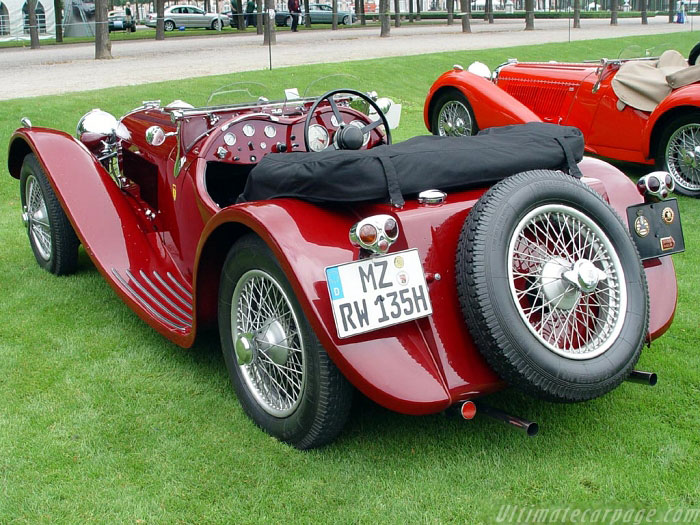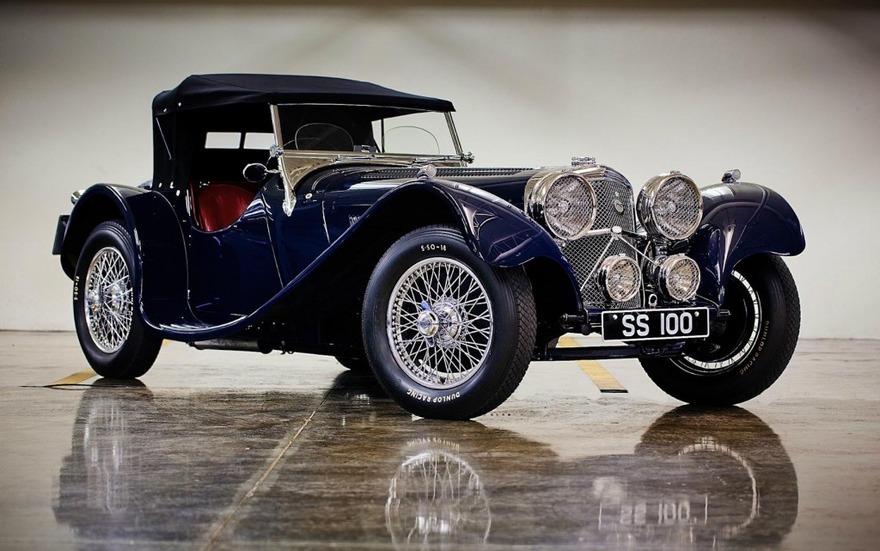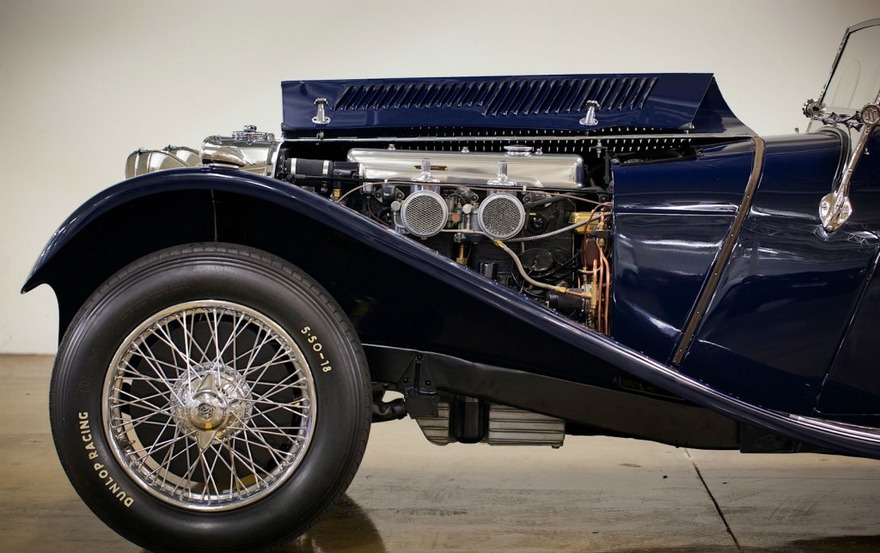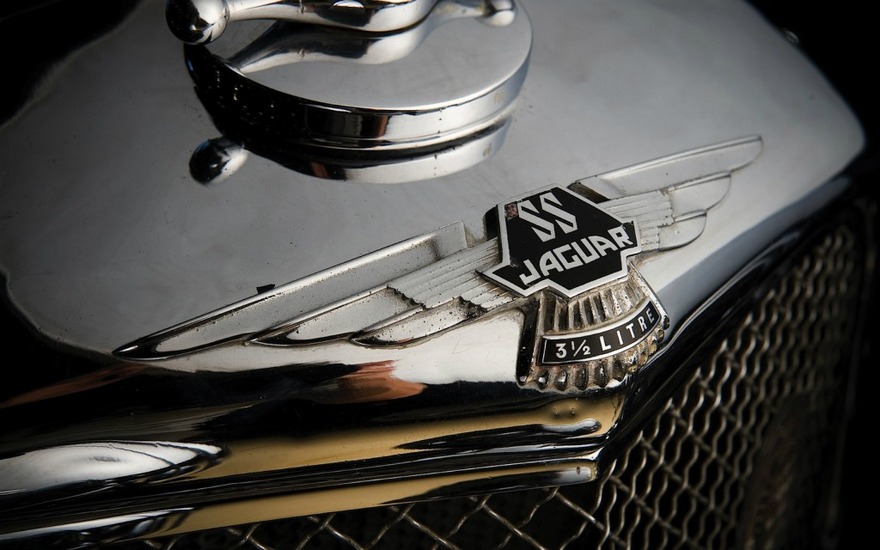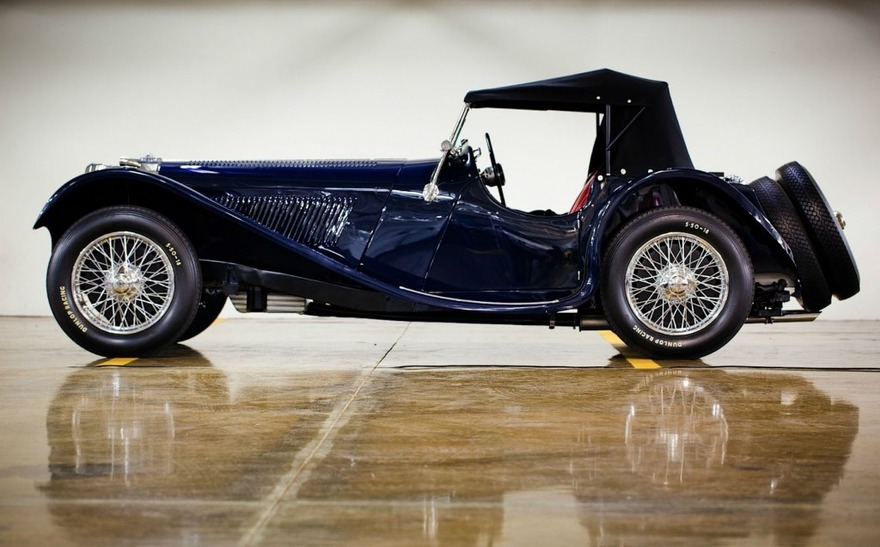In the beginning of the 1930’s British society was overwhelmed by a masterpiece of engineering. The audience and journalists were thrilled by what they saw at the event in London’s Mayfair Hotel, and William Lyons — joyfully rubbing his hands — was sincerely proud of what his company had created. It was the first sports car designed by Cars Ltd of Coventry — a company which he had bought out from his business partner. This car combined comfort, efficiency and incredible power; it was well-known throughout England and was able to accelerate up to 100 mph and was therefore named SS100.
Once upon a time two young talented men came across each other. In 1920 the family of William Walmsley moved from Stockport to Blackpool. In this town their son could continue his business of designing motorcycle sidecars which immediately attracted the attention of his nimble neighbour William Lyons. At first the latter bought one sidecar just as a matter of interest, and after that he offered the junior Walmsley to go into business. Being the heritor of his father’s piano business, Lyons had some money and, what was even more important, he knew how to run a business. As soon as William turned 21, the fellow neighbours registered Swallow Sidecars company. Though they say that there is no way to make a jaguar out of a swallow, the ambitious Englishmen managed to prove to the whole world that it was possible to perform a trick like that. A few years later, Lyons together with his assistants created a series of cars making his competitors delighted and jealous at the same time.
Walmsley and Lyons prepared an own-produced sedan for the 1931 exposition. It was difficult to define which of the two was better — a car named Standard Swallow or an advertisement telling about Jaguar’s wild manners. The most expensive Swallow model basing on Standard Ensign Six chassis cost £275 but it was stated in the ad that it had “the £1,000 look”. Moreover, the advertisement was peppered with such words as “comfort”, “charm”, “grace”, and “ideal car at ideal price”.
Most likely, those were Lyons and Bill Rankin, the company's public relations officer, who came up with the Jaguar name. After that the company invented a bonnet mascot calling it playfully “a cat shot off a fence”. From the very first steps of car manufacturing Lyons was paying a lot of attention to the correlation of the product’s offered price to the price that would seem most realistic to a regular customer. It was a proper step on his way to creating a perfect supercar.
“The exterior of Jaguar SS100 is best-in-class”, stated Lyons. It had a long bonnet, sensual wings, luxurious passenger compartment and interior decor. The dynamic silhouette and stylish body design of SS model was making a clear “I was made for sport” statement. Reliable side windows and roof cover together with an easy-to-read dashboard were adding “not only beautiful but also practical” impression. By 1938 the SS100 model was different from its predecessors only by having giant Girling drum brakes and big Lucas headlights. Technically, this model became a real masterpiece of Harry Weslake.
It happened that the former Bentley employee promised William Lyons to create a double-barrel carburettor, place the valves in the cylinder head and locate the camshaft above them. All these manipulations should have helped increasing the power of the car from 70 hp to 100 hp and also make it possible to combine it with a six-cylinder Standard unit.
The engine, which brought fame to Jaguar, was born only in 1943 when the company’s engineers were on their night fire watches during the World War II. Meanwhile, Harry Weslake, an expert from London, was fulfilling one promise after another. A short-chassis Jaguar SS100 with leaf-spring conventional suspension was truly bearing the heart of a wild cat. It had 6 cylinders with total 2.7-litre displacement and overhead valves, crankshaft supported by seven main bearings, light alloy rods and twin carburettors. Oh yes, it was also fitted with an electric fuel pump, allowing to produce 102 hp. William Lyons should have thought of Harry as a real magician.
Even in the middle 90’s the journalists who were performing tests of SS100 noted: “Though the model has a very primitive suspension and rough clutch, it still has excellent and responsive steering and effective brakes”.
In the beginning of its “career” Jaguar SS100 weighing 1170 kg was able to accelerate up to 94 mph (151 km/h). Later, by 1938 the open two-seater received a 3.5-litre version of the same engine able to produce 125 hp and accelerate up to 50 mph (80 km/h) in 7.1 seconds and up to 60 mph (96 km/h) in less than 9 seconds.
Jaguar became a fantastic car of the beginning of the 30’s. Twin carburettor, 4-speed clutch transmission — and the cat was ready to leap. Scoring Rally RAC victories three times in a row starting from 1937 and taking top places at Alpin Rally, Rally Monte-Carlo and Vila Real proved SS100 to become a real racing fighter. Nobody knew exactly what distance this cat had covered. However, everybody knew that after taking off all unnecessary parts that Jaguar was able to travel at a huge speed. The pilot Tommy Wisdom managed to reach 190.01 km/h during his best lap at the Long Handicap race in Brooklands. AutoCar journalists wrote: “When this car is handled right, few other cars can compete with it”.
Its eye-catching body with long low wings set on 18-inch wheels was a frequent podium winner in racing competitions, but World War II set an end to its triumph. As the initials SS were reminiscent of the Hitler hit squads, they had to change the company’s name to Jaguar Cars Ltd and the production of the superb and elegant series was over. SS100 became a truly world’s first sports car and the first most attractive model produced by Jaguar. It combines both rarity and reputation as only 116 cars fitted with 3.5-litre engine rolled off the production line. Today the price of this wild cat is €300,000. And though it was less than 100 years ago, the price of this car which used to be below £500 (in the very beginning of the 1930’s) disappeared in only one leap.
A legendary time leap was achieved by producing an unusual supercar in which the combustion engine is replaced by four electric motors (one per wheel) producing 195 hp each. This model weighs 1350 kg and its speed characteristics are incredible. The prototype is able to accelerate up to 160 km/h in 3.4 seconds and up to 300 km/h in only 15.7 seconds. Its top speed is 330 km/h. And the major constructors’ pride is active aerodynamics.
XKR-S model also belongs to the contemporary achievements of the company. Its uprated 5-litre AJ-V8 Gen III R V8 all-aluminium Vortex Roots-Type Supercharged powerplant puts out 550 hp at 6000 rpm with maximum torque of 680 Nm at 2500 rpm and is capable of 314-km/h top speed.
Moreover, Jaguar is the only company to use model indexing system based on... top speed. Jaguar SS100 and XK100 started this tradition. Those models were capable of reaching 100 mph (a bit more than 160 km/h). After them came XK120, XK140, and XK150... And finally it was the XJ220. Although the British Collector Car Guide states that the actual top speed of this supercar is “only” 217 mph and not 220. And that makes 350 km/h after converting this number into metric system!
And it is true to say that nowadays only a few car brands have as many outstanding characteristics and are as rich in traditions as Jaguar.
Photos: www.autocries.ru, www.carpedia.ru, www.ultimatecarspage.com

